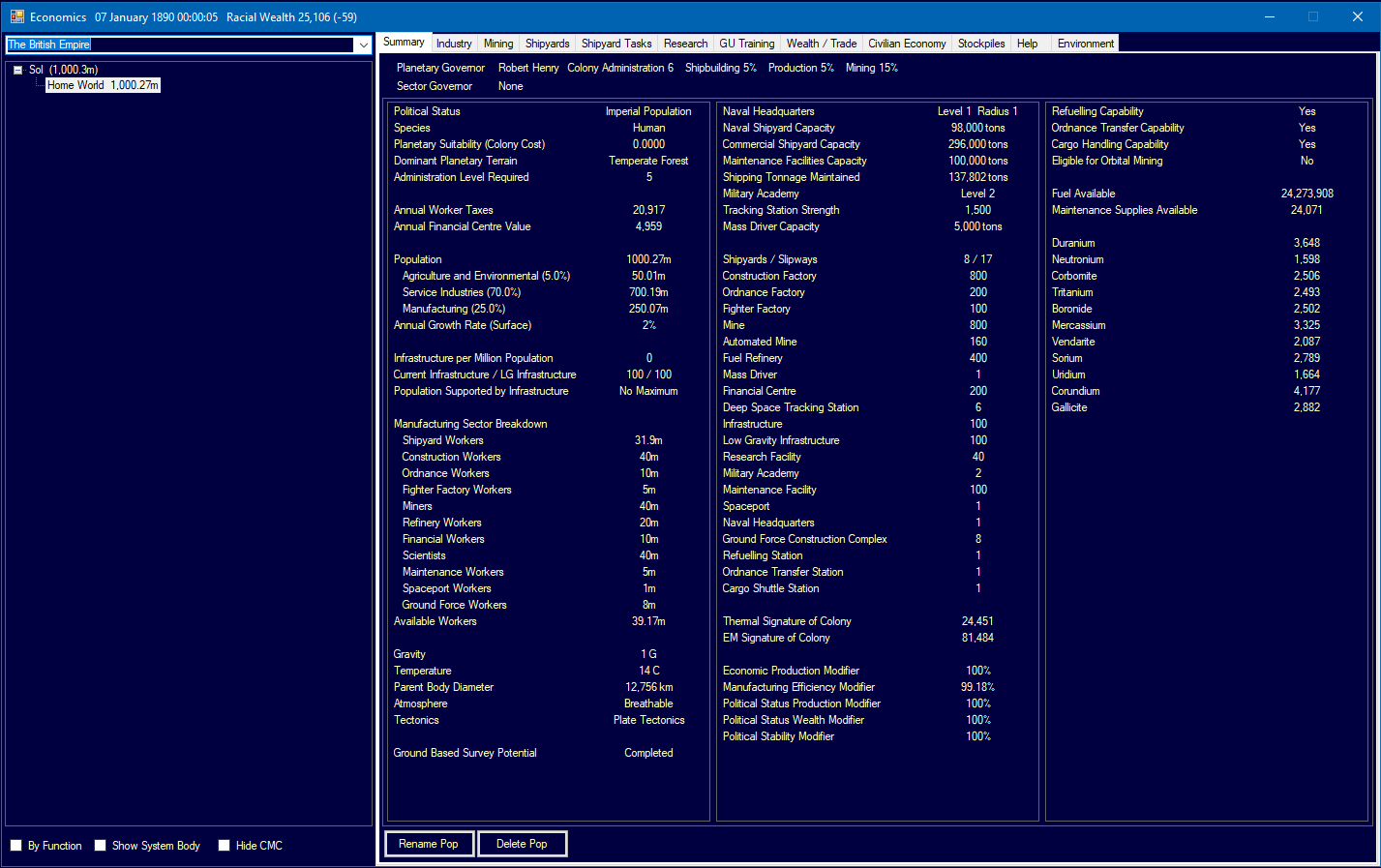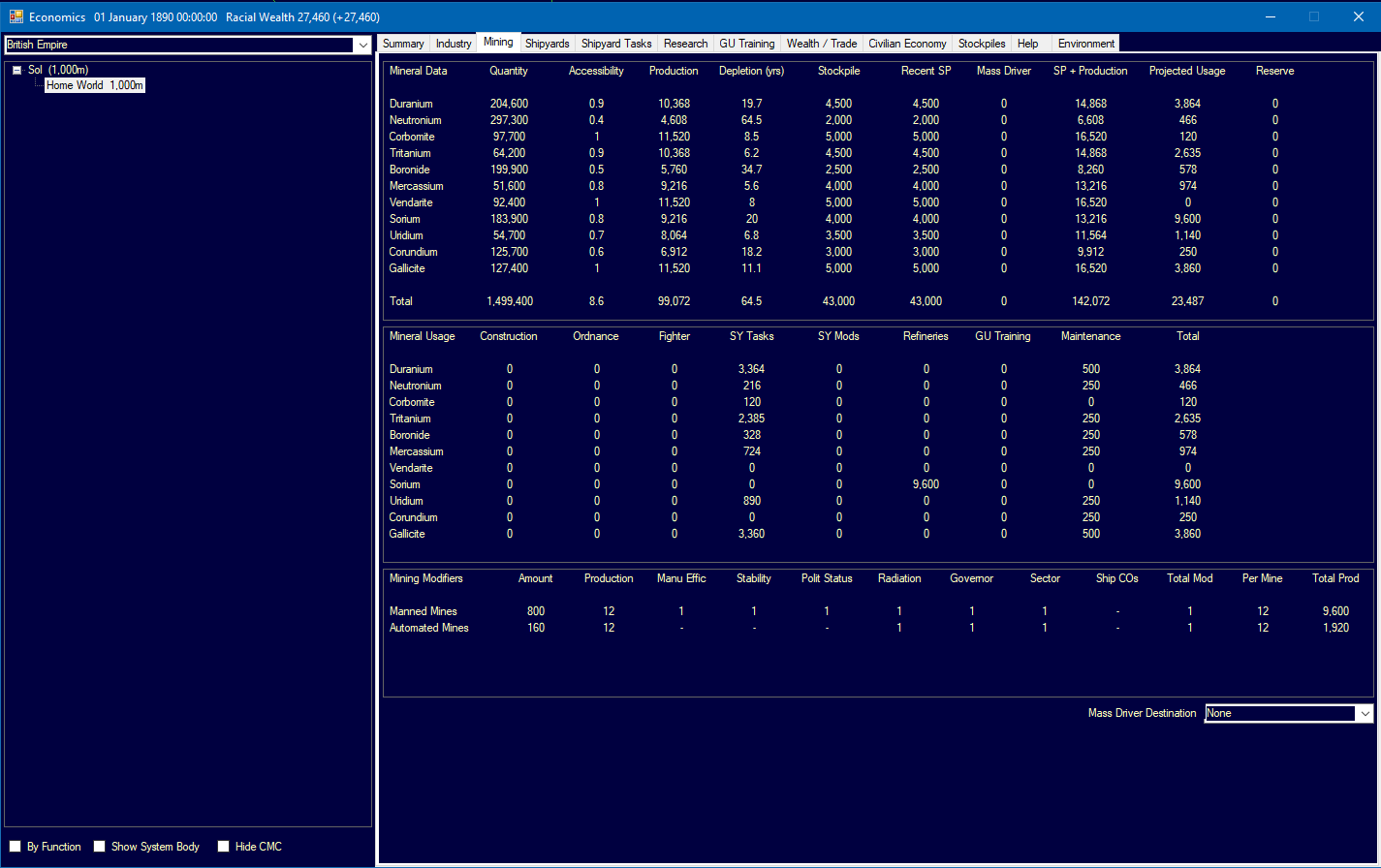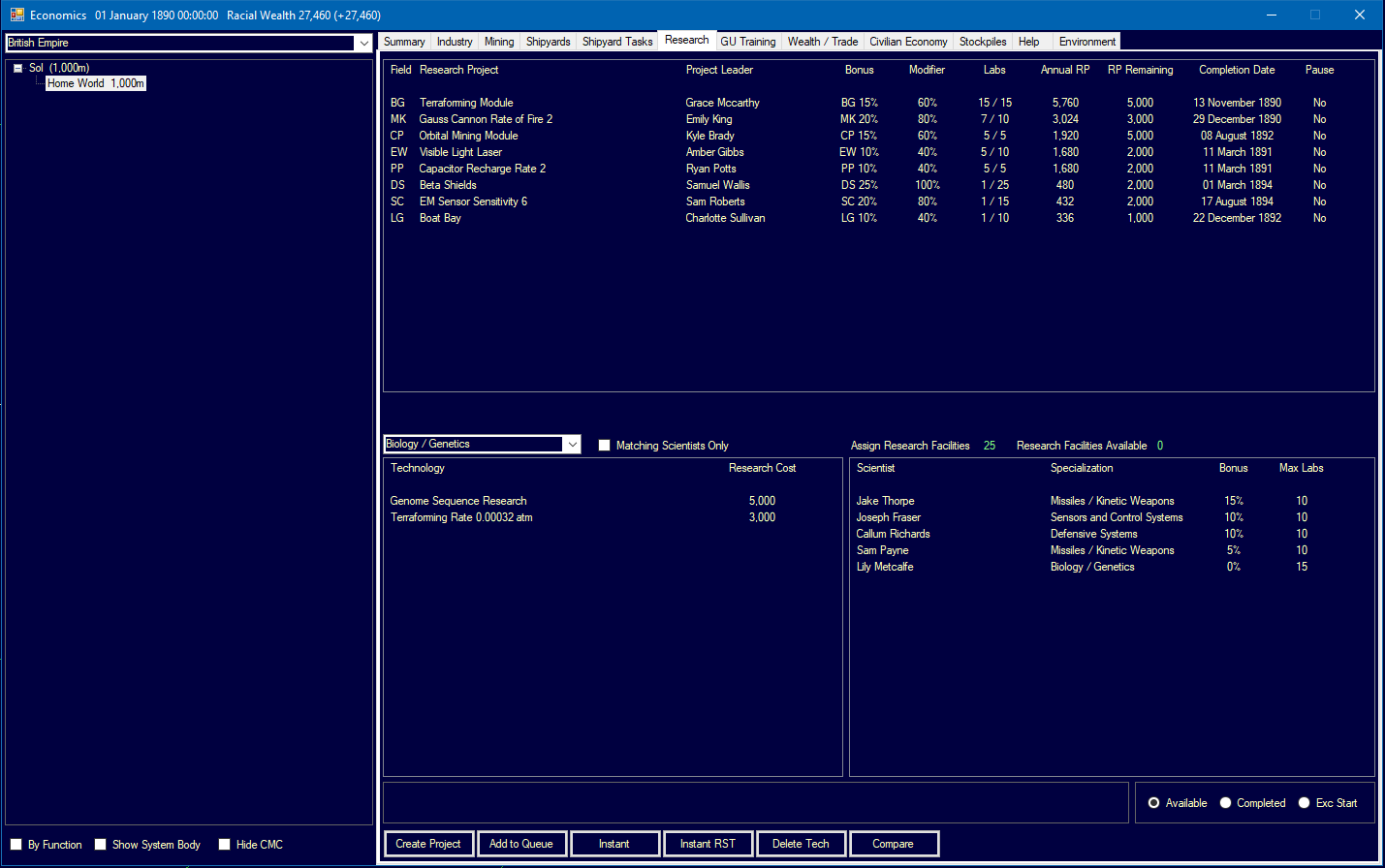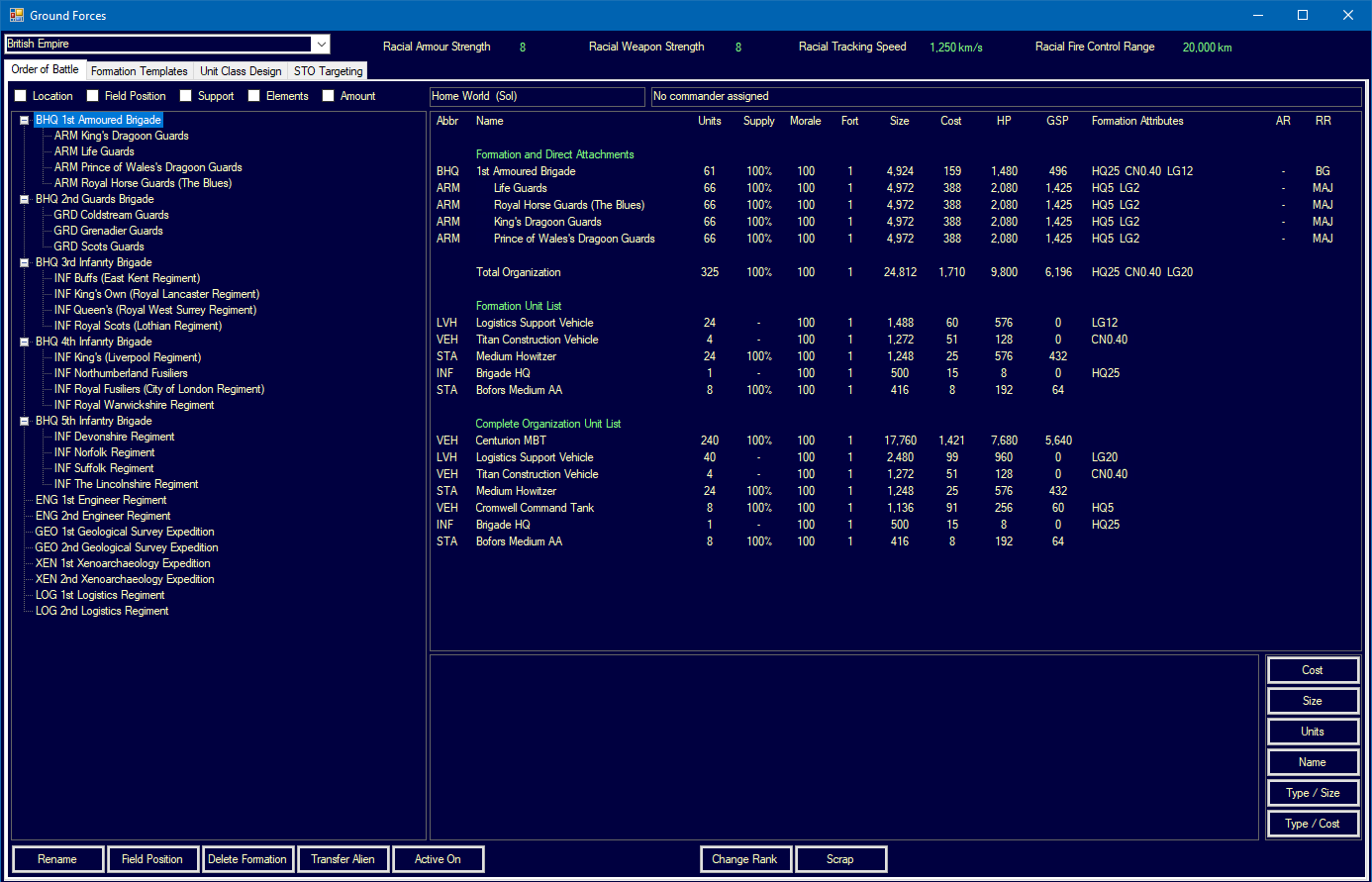The Suns Never Set In April 1860, an expedition led by the Scottish explorer John McDouall Stuart discovered the crash site of an alien spacecraft in central Australia, close to the mountain that now bears his name. While he could not fully comprehend the implications of the discovery, Stuart ensured the members of the expedition remained silent while the authorities were informed.
Within twelve months, under conditions of great secrecy, a group of top scientists from across the British Empire had assembled at the newly constructed Camp Stuart. The inaccessible, isolated location and the limited European population in Australia at the time allowed the Empire to maintain complete security for many years. At first, progress was glacially slow. As time passed and the scientists began to activate the remaining intact systems, the gradual flow of knowledge become a flood. An understanding of the Trans-Newtonian principles on which the spacecraft was based began to develop. The Empire scientists discovered that another dimension, which they named the Aether, existed alongside our own. The Aether had fluidic properties and was far more compressed in terms of distance between objects compared to ‘normal’ space. Eleven new elements were identified that existed primarily in the Aether but could be extracted and refined for construction purposes. Although the ramifications of these early discoveries were profound, it would take decades to fully realise their potential.
By 1870, ten years after the discovery, Great Britain was using tanks and the first jet aircraft to expand the Empire. In 1875, the British Empire sent a man to the Moon. Other major powers of the time were astonished at the apparently miraculous advancements in British military technology. Across the globe, from America to China, in the Russian and French empires, in the embryonic states of Germany and Italy and within rapidly modernizing Japan, valiant efforts were made to withstand the irresistible march of the Empire.
They were in vain. Despite their great strides in many fields of science, engineering and military technology, the lead of the British Empire only increased as it took full advantage of the knowledge extracted from alien computers. Even the widespread deployment of conventional armoured vehicles by the great powers was futile in the face of Trans-Newtonian tanks supported by orbital bombardment. By 1880, the wars were over and the British Empire ruled the land and the waves.
The Empire was in the fortunate position of possessing technology that literally changed the world. A conquering power that brought medicines to the sick and food to the starving was soon seen as a liberator. Apart from the initial occupying forces, the introduction of new laws and the high level direction of science and industry, the Empire governed with a light touch. Existing local authorities were left in place as much as possible and the various monarchies were absorbed into the house of Saxe-Coburg and Gotha.
With Earth united under Queen Victoria, the Empire turned its attention turned to the exploration of space. The crashed alien spacecraft had enabled huge technological strides in a few short decades, but also represented a grave threat to mankind. Once its existence was finally made public in 1887, the initial alarm of the citizens of the Empire soon translated into support for the growing space forces of the Royal Navy. The decision was made to hold the warships in orbit until the first survey cruisers were available. On January 1st 1890, the Empire took the first steps into deep space.
Starting Conditions:1 Player Race with one billion pop and normal TN start. 160,000 Research Points.
2 Non-Player Races. Precursors and Swarm active.



 Starting Forces
Starting Forces2x Royal Sovereign class battleship:
Royal Oak, Royal Sovereign.2x Diadem class heavy cruiser:
Andromeda, Diadem.3x Pelorus class light cruiser:
Pandora, Pegasus, Pelorus.4x Apollo class survey cruiser:
Aeolus, Andromache, Apollo, Intrepid.4x Scylla class survey cruiser:
Scylla, Sirius, Spartan, Sybille.2x Hyperion class Jump Tender:
Hyperion, Eos2x Demeter class Tanker:
Demeter, Thesmophoros 2x Atlas class Tug:
Atlas, Hercules4x Hera class Jump Point Stabilisation Ship
2x Ares class Troop Transport
2x Athena class colony ship
2x Poseidon class freighter
Ship Classes of the Royal NavyThe Royal Navy went into space with more than three hundred years of experience as a premier, blue water navy. This experience translated into an emphasis by the Royal Navy’s shipwrights on the most capable, long-ranged weapons, complemented by strong armour, and a combat doctrine that emphasised those weapons. While energy weapons were initially considered as a potential secondary weapon, a decision was made in the early years of spacecraft design to focus all research efforts on missile technology for the first warships. Energy weapons would be researched in the future as resources and capacity become available.
The Royal Sovereign class Battleship was the embodiment of this philosophy. Equipped with a dozen torpedo launchers backed by strong armour, the Royal Sovereign was intended to operate at the heart of the battle fleet, combining with its sister ships to overwhelm any foe with massed torpedo salvos. The Theseus torpedo was the primary weapon of the Royal Sovereign and made full use of the available sensor and fire control range. The Perseus torpedo exchanged range for additional warhead strength, allowing the battleship to increase its throw weight at shorter ranges.
Royal Sovereign class Battleship 15,000 tons 371 Crew 1,920.7 BP TCS 300 TH 1,200 EM 0
4005 km/s Armour 6-54 Shields 0-0 HTK 94 Sensors 10/10/0/0 DCR 8 PPV 60
Maint Life 2.25 Years MSP 641 AFR 224% IFR 3.1% 1YR 171 5YR 2,572 Max Repair 150 MSP
Magazine 700
Captain Control Rating 1 BRG
Intended Deployment Time: 12 months Morale Check Required
Parsons PN-300 Triple Expansion Ion Drive (4) Power 1200 Fuel Use 50.60% Signature 300 Explosion 10%
Fuel Capacity 1,000,000 Litres Range 23.7 billion km (68 days at full power)
Mk I Naval Torpedo Launcher (12) Missile Size: 5 Rate of Fire 25
Maxwell MF-50 Torpedo Fire Control (2) Range 52.8m km Resolution 120
Theseus Torpedo (116) Speed: 19,200 km/s End: 43m Range: 50.6m km WH: 6 Size: 5.00 TH: 64/38/19
Perseus Torpedo (24) Speed: 19,200 km/s End: 29m Range: 33.7m km WH: 9 Size: 5.00 TH: 64/38/19
Maxwell MX-50 Area Surveillance Sensor (1) GPS 8640 Range 52.8m km Resolution 120
Rutherford RT-10 Passive Thermal Sensor (1) Sensitivity 10 Detect Sig Strength 1000: 25m km
Rutherford RE-10 Passive EM Sensor (1) Sensitivity 10 Detect Sig Strength 1000: 25m km
The Diadem class heavy cruiser was a smaller version of the Royal Sovereign, equipped with fewer torpedo launchers and lighter armour. The Diadem was intended to serve as a multi-role ship, able to function in the line of battle but also to operate as part of a small independent squadron. The distinction was more philosophical than practical as the Diadem had the same broad combat capability as its larger cousin, albeit on a smaller scale. In effect, the Diadem was considered more expendable than the capital ships, which would only be risked in a major fleet battle. For an officer or sailor with a desire to see the galaxy, posting to a Diadem class was far more desirable than being assigned to a Royal Sovereign that was likely to spend the majority of its life orbiting Earth, or some future key planet.
Diadem class Heavy Cruiser 9,000 tons 241 Crew 1,165.1 BP TCS 180 TH 720 EM 0
4003 km/s Armour 4-38 Shields 0-0 HTK 55 Sensors 5/5/0/0 DCR 5 PPV 40
Maint Life 2.60 Years MSP 404 AFR 129% IFR 1.8% 1YR 84 5YR 1,264 Max Repair 120 MSP
Magazine 448
Commander Control Rating 1 BRG
Intended Deployment Time: 12 months Morale Check Required
Parsons PN-240 Triple Expansion Ion Drive (3) Power 720 Fuel Use 56.57% Signature 240 Explosion 10%
Fuel Capacity 500,000 Litres Range 17.7 billion km (51 days at full power)
Mk I Naval Torpedo Launcher (8) Missile Size: 5 Rate of Fire 25
Maxwell MF-50 Torpedo Fire Control (1) Range 52.8m km Resolution 120
Theseus Torpedo (89) Speed: 19,200 km/s End: 43m Range: 50.6m km WH: 6 Size: 5 TH: 64/38/19
Maxwell MX-50 Area Surveillance Sensor (1) GPS 8640 Range 52.8m km Resolution 120
Rutherford RE-5 Passive EM Sensor (1) Sensitivity 5 Detect Sig Strength 1000: 17.7m km
Rutherford RT-5 Passive Thermal Sensor (1) Sensitivity 5 Detect Sig Strength 1000: 17.7m km
The Apollo class survey cruiser was an armed gravitational survey ship. The Apollo and its near-identical geological equivalent, the Scylla class, were intended for deep space, long duration missions. As the Admiralty insisted from the early years of the Trans-Newtonian Era that all Royal Navy ships, as opposed to the support ships of the Royal Fleet Auxiliary, must be combat capable, the Apollo and Scylla classes had a light armament to defend themselves against hostile aliens. Unlike the Royal Sovereign and Diadem classes, the Apollos were equipped with a jump drive, which would allow them to explore new systems. Due to the need to incorporate three survey sensors, a jump drive, a basic armament and triple the endurance of the dedicated warship classes, the Apollo class was as large as a Diadem class heavy cruiser. Even so, the armour was very light and the ship would struggle against any serious opposition.
Apollo class Survey Cruiser 9,000 tons 231 Crew 1,123.2 BP TCS 180 TH 504 EM 0
2801 km/s JR 3-50 Armour 2-38 Shields 0-0 HTK 57 Sensors 2/2/3/0 DCR 8 PPV 10
Maint Life 4.01 Years MSP 624 AFR 81% IFR 1.1% 1YR 62 5YR 930 Max Repair 158.2 MSP
Magazine 112
Captain Control Rating 1 BRG
Intended Deployment Time: 36 months Morale Check Required
Tesla TJD-9000 Military Jump Drive Max Ship Size 9000 tons Distance 50k km Squadron Size 3
Parsons PN-250E Triple Expansion Ion Drive (2) Power 504 Fuel Use 18.94% Signature 252 Explosion 7%
Fuel Capacity 725,000 Litres Range 76.6 billion km (316 days at full power)
Mk I Naval Torpedo Launcher (2) Missile Size: 5 Rate of Fire 25
Maxwell MF-36 Torpedo Fire Control (1) Range 36.1m km Resolution 120
Orpheus Passive Sensor Drone (4) Speed: 4,800 km/s End: 12d Range: 5,229m km WH: 0 Size: 5
Perseus Torpedo (18) Speed: 19,200 km/s End: 29m Range: 33.7m km WH: 9 Size: 5
Maxwell MX-36 Area Surveillance Sensor (1) GPS 4320 Range 37.3m km Resolution 120
Rutherford RT-2 Passive Thermal Sensor (1) Sensitivity 2 Detect Sig Strength 1000: 11.2m km
Rutherford RE-2 Passive EM Sensor (1) Sensitivity 2 Detect Sig Strength 1000: 11.2m km
Gravitational Survey Sensors (3) 3 Survey Points Per Hour
The Pelorus class light cruiser was a fleet defence ship, intended to detect and intercept hostile torpedoes, using the Daedalus Anti-Torpedo Torpedo, commonly shortened to the Daedalus ATT. The Pelorus was intended to fight either in the battle line or as part of an independent squadron and therefore had the same armour as the Diadem. A Pelorus would never be intentionally deployed alone.
Pelorus class Light Cruiser 6,000 tons 133 Crew 792.9 BP TCS 120 TH 480 EM 0
4003 km/s Armour 4-29 Shields 0-0 HTK 44 Sensors 0/0/0/0 DCR 3 PPV 15
Maint Life 2.36 Years MSP 247 AFR 96% IFR 1.3% 1YR 61 5YR 909 Max Repair 120 MSP
Magazine 423
Captain Control Rating 1 BRG
Intended Deployment Time: 12 months Morale Check Required
Parsons PN-240 Triple Expansion Ion Drive (2) Power 480 Fuel Use 56.57% Signature 240 Explosion 10%
Fuel Capacity 375,000 Litres Range 19.9 billion km (57 days at full power)
Mk II AT Torpedo Launcher (15) Missile Size: 1 Rate of Fire 10
Maxwell MF-10A Anti-Torpedo Fire Control (3) Range 9.6m km Resolution 1
Daedalus AT Torpedo (423) Speed: 33,600 km/s End: 1m Range: 2.5m km WH: 1 Size: 1 TH: 123/73/36
Maxwell MX-10A Torpedo Warning Sensor (1) GPS 60 Range 9.8m km MCR 1.1m km Resolution 1
The two Hyperion class Jump Tenders served as part of the Royal Fleet Auxiliary (RFA), along with a number of other ship types such as tugs, tankers, stabilisation ships and freighters. Their primary function was to station themselves at a jump point to facilitate the movement of other RFA assets, with the wider goal of supporting Royal Navy deployments and the economic growth of the Empire.
Hyperion class Jump Tender 66,150 tons 340 Crew 1,145.2 BP TCS 1,323 TH 2,016 EM 0
1523 km/s JR 2-25(C) Armour 1-145 Shields 0-0 HTK 120 Sensors 5/5/0/0 DCR 1 PPV 0
MSP 10 Max Repair 497.1 MSP
Commander Control Rating 1 BRG
Intended Deployment Time: 3 months
JC128K Commercial Jump Drive Max Ship Size 127500 tons Distance 25k km Squadron Size 2
CD-144E Commercial Drive (14) Power 2016 Fuel Use 1.97% Signature 144 Explosion 3%
Fuel Capacity 2,000,000 Litres Range 275.9 billion km (2096 days at full power)
Refuelling Capability: 50,000 litres per hour Complete Refuel 40 hours
Maxwell MX-20 Navigation Sensor (1) GPS 1440 Range 21.6m km Resolution 120
Rutherford RE-5 Passive EM Sensor (1) Sensitivity 5 Detect Sig Strength 1000: 17.7m km
Rutherford RT-5 Passive Thermal Sensor (1) Sensitivity 5 Detect Sig Strength 1000: 17.7m km
1890The gravitational survey of Sol was completed in August 1890, revealing five jump points. Two were extremely close to the sun, located at five and eight million kilometres, with the other three positioned almost in a line on bearings between forty and forty-six degrees and distances of one point one, one point seven and three point seven billion kilometres. The outermost jump point led to Alpha Centauri, a binary of a yellow G2-V star and an orange K7-V. The two stars had ten planets and twenty-eight moons between them, including an ideal habitable world. Alpha Centauri-A III was a hot, jungle world, slightly larger than Earth, with great oceans covering two-thirds of the surface. Its mineral deposits included seven million tons of Duranium at 0.4 accessibility, plus three other minerals at 0.1 accessibility. The colony of Nova Terra was established on the planet in late 1890.
In order of ascending distance, the other jump points led to Thebes, Argos, Proxima and Rhodes. After the Sol jump points were explored, Queen Victoria decreed any systems without commonly known names should be named after cities or regions from Classical Antiquity. Argos was a brown dwarf system. Proxima and Rhodes both had red dwarf primaries, while Thebes was a red dwarf binary. The small colonies of Cadmea and Colossus were established on colony cost 2.00 planets in Thebes I and Rhodes III respectively and the Argolis Automated Mining Colony was established on the seventh moon of Argos-B II. Cadmea was a small, hot tide-locked world lacking both air and water that had deposits of eight different minerals between minimal and medium accessibility. Colossus was a frozen world with plentiful water locked up in ice sheets and a thin (0.08 atm) nitrogen-oxygen atmosphere. It had over a million tons of accessibility 1.0 Duranium. The Argolis mining colony had deposits of ten minerals, most of which were large and accessible. A small colony was also established on Mars, despite its limited minerals.
Argolis Automated Mining Colony Survey ReportDuranium: 1,943,874 0.90
Neutronium: 314,145 1.00
Tritanium: 242,761 0.50
Boronide: 2,198 0.70
Mercassium: 34,681 0.50
Vendarite: 2,288,824 0.60
Sorium: 2,553,201 0.70
Uridium: 22,833 1.00
Corundium: 2,445,866 0.40
Gallicite: 1,943,121 0.20
Cadmea Colony Survey ReportDuranium: 12,610,242 0.40
Neutronium: 2,537,649 0.10
Corbomite: 88,209 0.20
Tritanium: 236,196 0.50
Mercassium: 944,784 0.10
Vendarite: 3,674,889 0.30
Uridium: 2,205,225 0.10
Corundium: 7,001,316 0.10
Colossus Colony Survey ReportDuranium: 1,371,168 1.00
Neutronium: 3,240,000 0.10
Corbomite: 166,400 0.10
Boronide: 8,714,304 0.10
By the end of the year, the four Apollo class survey cruisers had surveyed all the systems adjacent to Sol, except for Alpha Centauri, and explored three jumps out from Sol via both Proxima and Thebes. In Sol, civilian mining colonies were created on the dwarf planet Haumea, the comet Borrelly and Ariel, a moon of Uranus. The Webb Freight Line launched a freighter and a colony ship, which concentrated on the expansion of the Mars colony, although the colony ship also visited the Nova Terra colony in Alpha Centauri.
The first Helios class Harvester Station, equipped with forty-eight harvester modules, was built by Earth-based construction factories in December 1890 and towed into orbit of Saturn, which had 180,000 tons of accessibility 1.0 Sorium. The Fairfield Shipbuilding orbital shipyard completed three Poseidon class freighters, while Empire scientists developed the Terraforming Module, which would be incorporated into a new space station design.
 1891
1891Ship construction preceded apace in 1891, with the completion of the Royal Sovereign class battleships
Repulse,
Resolution and
Revenge, the Diadem class heavy cruisers
Argonaut,
Ariadne and
Europa, the Apollo class survey cruisers
Thetis and
Tribune and the Pelorus class light cruisers
Pioneer and
Perseus. Six freighters and three colony ships joined the Royal Fleet Auxiliary, along with the first Genesis class terraforming station.
The survey cruisers continued to expand the boundaries of the Empire, exploring beyond Alpha Centauri and reaching four transits out beyond the Sol – Proxima jump point. Ten new systems were discovered during 1891, the most important of which was Sparta; a binary system comprising an orange K3-V primary, a red dwarf M4-V companion, thirteen planets, one hundred and seventy-three moons and two hundred and twenty asteroids. Sparta-A II was Earth-sized with gravity of 1.02G, a breathable nitrogen-oxygen atmosphere of 1.06 atm and a surface temperature of -12.6C. With liquid oceans covering 56% of the surface, Sparta-A II was close to an ideal habitable world and had a colony cost of 0.12. The land surface was dominated by forested mountains. A geological survey revealed the planet had all eleven trans-Newtonian minerals, including a million tons of accessibility 1.0 Duranium.
The innermost planet of the companion also had a nitrogen – oxygen atmosphere, which would become breathable if the small amount of carbon dioxide was removed. Sparta-B I was a frozen, mountainous world with ice sheets covering ninety-seven percent of the surface. Once the CO2 was extracted, the colony cost would be 0.67 due to the temperature of -91C. The planet had extensive deposits of ten different minerals, although Duranium was at 0.1 accessibility. In fact, the whole Sparta system was replete with useful mineral deposits, particularly among the asteroid belt. The nomenclature of the system was based on its obvious importance and the fact it was discovered by the survey cruiser
Spartan. The Leonidas colony was established on Sparta-A II in September 1891.
Sparta-A I Survey ReportDuranium: 352,800 0.90
Neutronium: 22,500 0.70
Corbomite: 2,500 0.70
Tritanium: 940,900 1.00
Mercassium: 756,900 0.90
Leonidas Colony Survey ReportDuranium: 1,059,968 1.00
Neutronium: 2,822,400 0.10
Corbomite: 1,960,000 0.10
Tritanium: 27,709,696 0.10
Boronide: 12,845,056 0.50
Mercassium: 20,070,400 0.20
Vendarite: 6,927,424 0.60
Sorium: 6,071,296 0.10
Uridium: 1,016,064 0.10
Corundium: 19,571,776 0.10
Gallicite: 21,603,904 0.10
Sparta-B I Survey ReportDuranium: 33,620,000 0.10
Neutronium: 1,317,904 0.10
Corbomite: 60,684,100 0.50
Tritanium: 6,885,376 0.90
Boronide: 968,256 0.10
Mercassium: 37,822,500 0.10
Vendarite: 6,051,600 0.50
Sorium: 44,116,164 0.10
Corundium: 38,837,824 0.60
Gallicite: 16,810,000 0.30
Sparta-B III – Moon 10 Survey ReportDuranium: 30,201,992 0.80
Neutronium: 568,516 0.10
Corbomite: 19,945,156 0.10
Vendarite: 23,174,596 0.40
Uridium: 1,089,936 0.30
Corundium: 659,344 0.10
Gallicite: 7,431,076 0.10
The second notable survey event in 1891 was the discovery of a destroyed alien outpost in the Memphis system, located three jumps from Sol via Thebes and Sardis. An Ares class troop transport was dispatched with the 1st Xenoachaeological Expedition and the 1st Engineer Regiment, plus the Royal Warwickshire Regiment to provide security.
Each infantry regiment comprised eight hundred infantrymen, forty Bren light machine guns, four medium anti-tank guns, four logistics sections and the regimental HQ. The brigade elements comprised twenty-four medium howitzers, eight Bofors medium ant-aircraft guns, four Titan construction vehicles, twenty-four logistics support vehicles and the brigade HQ. While the infantry regiments provided the backbone of the Empire ground forces, the armoured regiments provided the striking power. Each one comprised sixty 74-ton Centurion main battle tanks, two Cromwell command tanks and four logistics support vehicles. The Centurion was well-armoured and equipped with a medium anti-tank weapon and a light autocannon.
By mid-1891, the Empire had adopted a policy of colonising at least one planet or moon in systems where colony cost 2.00 worlds were found, even when no minerals were available. This was an aspirational objective and limited by the availability of both infrastructure and transport lift. The latter was soon in short supply due to a major effort to expand the Leonidas colony. Because of these constraints, systems closer to Sol or worlds with more potential were given priority. A deep space tracking station and an infantry regiment were transported to each new colony, with the exceptions of the Nova Terra and Leonidas colonies, which each merited an infantry brigade with four regiments.
The Artemis colony was created on Ephesus III, a small, tide-locked terrestrial world with water locked within ice sheets but no atmosphere and no minerals. Ephesus was a strategic system as it lay on the route Sol – Rhodes – Ephesus - Sparta. The Croesus and Tigris colonies were established on similar icy worlds in the Sardis and Seleucia systems, both adjacent to Thebes. One jump beyond Sardis, the Indus colony was established on Epsilon Indi III, another airless world with frozen water, although in this case the colony had significant mineral deposits, including three hundred thousand tons of accessibility 0.9 Duranium.
Indus Colony Survey ReportDuranium: 313,632 0.90
Neutronium: 331,776 0.50
Corbomite: 39,204 0.40
Vendarite: 2,802,276 0.10
Sorium: 2,566,404 0.20
Uridium: 876,096 1.00
Corundium: 54,756 0.10
Gallicite: 544,644 0.10
1892No new colonies were established in 1892, although some of the existing colonies were expanded. The Leonidas colony in Sparta was the focus of the primary effort, with a Refuelling Station, an Ordnance Transfer Station and a dozen maintenance facilities transported to the colony from Earth. A Demeter class tanker brought fuel to support further survey operations beyond Sparta. The newly-formed Sparta Squadron, comprising the Diadem class heavy cruiser
Andromeda and the Pelorus class light cruiser
Pandora took up residence in orbit, establishing a new fleet area that would be known to the Royal Navy as the Sparta Station.
Jackson Transport Lines, a second Empire shipping line, was formed in 1892 and began transporting infrastructure to the various colonies. By the end of the year the two shipping lines had a total of four freighters, two liners and a colony ship in operation.
In Memphis, the ruins were surveyed and the alien language deciphered. Eight abandoned installations were identified as having potential for recovery, resulting in the reclamation of two mines, two automated mines, two construction factories and four maintenance facilities. The site was subsequently abandoned, with the installations and ground forces transported to Earth.
New ship construction included the Diadem heavy cruiser
Niobe, the Pelorus class light cruisers
Prometheus and
Proserpine, a third Hyperion class jump tender, three Poseidon II class freighters, a new design with double the transport capacity of the original Poseidon, and the second Genesis class terraforming station. Both Genesis class stations were towed into orbit of the Leonidas class colony where they gradually added Aestusium to the atmosphere in order to bring the temperature into the habitable range.
Four new systems were discovered during the year. Palmyra was a planetless red dwarf that lay three jumps from Sol via Alpha Centauri and Tau Ceti, while Syracuse was a planetless white dwarf three jumps from Sol via Argos and Tegea. The survey of Sparta revealed a single new jump point which led to Marathon, another unremarkable red dwarf, which itself had only one new jump point that led to Gamma Pavonis. The newly discovered system, comprising a bright, yellow-white F6-V primary, eight planets, thirty-six moons and a moderate-sized asteroid belt, was five transits from Sol and the furthest point to be explored so far. A geological survey was underway at the end of 1892.